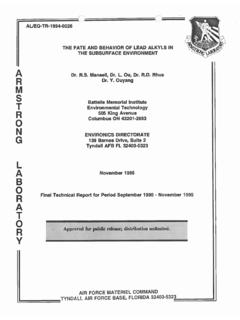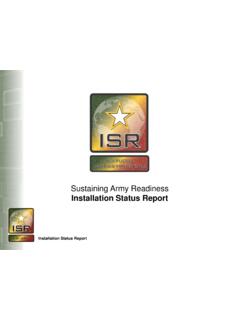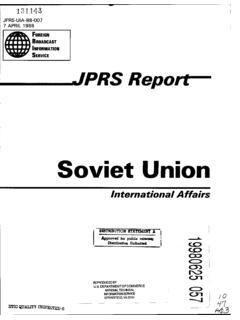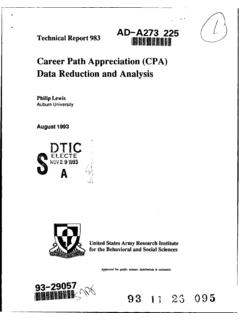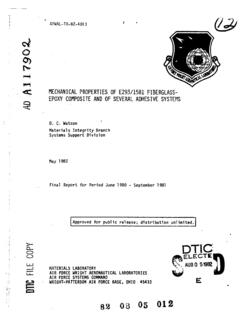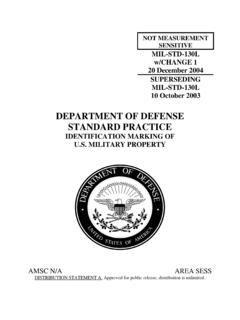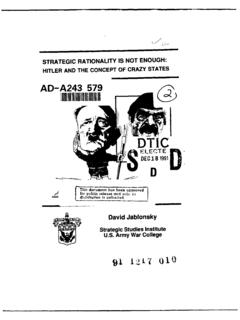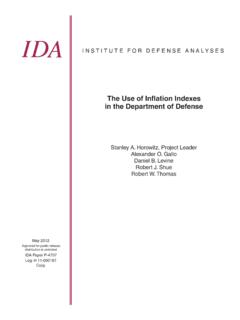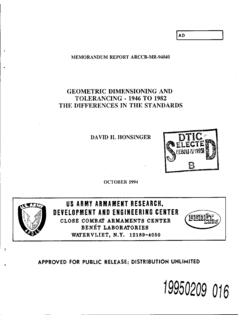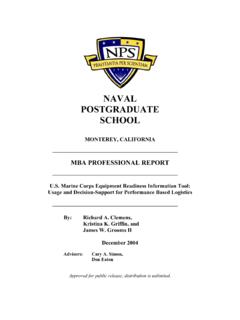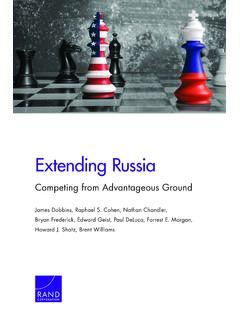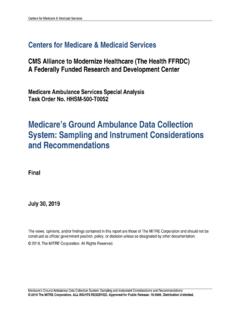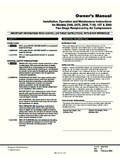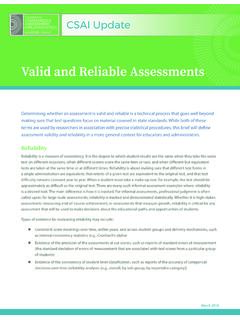Transcription of THE ARTS CHILD POLICY CIVIL JUSTICE EDUCATION 6 …
1 This document and trademark(s) contained herein are protected by law as indicated in a notice appearing later in this work. This electronic representation of rand intellectual property is provided for non-commercial use only. Unauthorized posting of rand PDFs to a non- rand Web site is prohibited. rand PDFs are protected under copyright law. Permission is required from rand to reproduce, or reuse in another form, any of our research documents for commercial use. For information on reprint and linking permissions, please see rand Electronic Distribution RightsThis PDF document was made available from as a public service of the rand down to documentTHE ARTSCHILD POLICYCIVIL JUSTICEEDUCATIONENERGY AND ENVIRONMENTHEALTH AND HEALTH CAREINTERNATIONAL AFFAIRSNATIONAL SECURITYPOPULATION AND AGINGPUBLIC SAFETYSCIENCE AND TECHNOLOGYSUBSTANCE ABUSETERRORISM AND HOMELAND SECURITYTRANSPORTATION ANDINFRASTRUCTUREWORKFORCE AND WORKPLACEThe rand corporation is a nonprofit research organization providing objective analysis and effective solutions that address the challenges facing the public and private sectors around the rand at the rand National Defense Research InstituteView document detailsFor More InformationPurchase this documentBrowse Books & PublicationsMake a charitable contributionSupport RANDR eport Documentation PageForm ApprovedOMB No.
2 0704-0188 Public reporting burden for the collection of information is estimated to average 1 hour per response, including the time for reviewing instructions, searching existing data sources, gathering andmaintaining the data needed, and completing and reviewing the collection of information. Send comments regarding this burden estimate or any other aspect of this collection of information,including suggestions for reducing this burden, to Washington Headquarters Services, Directorate for Information Operations and Reports, 1215 Jefferson Davis Highway, Suite 1204, ArlingtonVA 22202-4302. Respondents should be aware that notwithstanding any other provision of law, no person shall be subject to a penalty for failing to comply with a collection of information if itdoes not display a currently valid OMB control number. 1. REPORT DATE 2009 2. REPORT TYPE 3. DATES COVERED 00-00-2009 to 00-00-2009 4.
3 TITLE AND SUBTITLE Data Collection Methods. Semi-Structured Interviews and Focus Groups 5a. CONTRACT NUMBER 5b. GRANT NUMBER 5c. PROGRAM ELEMENT NUMBER 6. AUTHOR(S) 5d. PROJECT NUMBER 5e. TASK NUMBER 5f. WORK UNIT NUMBER 7. PERFORMING ORGANIZATION NAME(S) AND ADDRESS(ES) rand corporation ,1776 Main St,PO Box 2138,Santa Monica,CA,90407-2138 8. PERFORMING ORGANIZATIONREPORT NUMBER 9. SPONSORING/MONITORING AGENCY NAME(S) AND ADDRESS(ES) 10. SPONSOR/MONITOR S ACRONYM(S) 11. SPONSOR/MONITOR S REPORT NUMBER(S) 12. DISTRIBUTION/AVAILABILITY STATEMENT Approved for public release; distribution unlimited 13. SUPPLEMENTARY NOTES 14. ABSTRACT 15. SUBJECT TERMS 16. SECURITY CLASSIFICATION OF: 17. LIMITATION OF ABSTRACT Same asReport (SAR) 18. NUMBEROF PAGES 148 19a. NAME OFRESPONSIBLE PERSON a. REPORT unclassified b. ABSTRACT unclassified c. THIS PAGE unclassified Standard Form 298 (Rev. 8-98) Prescribed by ANSI Std Z39-18 This product is part of the rand corporation technical report series.
4 Reports may include research findings on a specific topic that is limited in scope; present discus-sions of the methodology employed in research; provide literature reviews, survey instruments, modeling exercises, guidelines for practitioners and research profes-sionals, and supporting documentation; or deliver preliminary findings. All rand reports undergo rigorous peer review to ensure that they meet high standards for re-search quality and Collection MethodsSemi-Structured Interviews and Focus GroupsMargaret C. Harrell, Melissa A. BradleyPrepared for the GovernmentApproved for public release; distribution unlimitedNATIONAL DEFENSE RESEARCH INSTITUTEThe R AND corporation is a nonprofit research organization providing objective analysis and effective solutions that address the challenges facing the public and private sectors around the world. R AND s publications do not necessarily reflect the opinions of its research clients and is a registered trademark.
5 Copyright 2009 R AND CorporationPermission is given to duplicate this document for personal use only, as long as it is unaltered and complete. Copies may not be duplicated for commercial purposes. Unauthorized posting of R AND documents to a non-R AND Web site is prohibited. R AND documents are protected under copyright law. For information on reprint and linking permissions, please visit the rand permissions page ( ).Published 2009 by the R AND Corporation1776 Main Street, Box 2138, Santa Monica, CA 90407-21381200 South Hayes Street, Arlington, VA 22202-50504570 Fifth Avenue, Suite 600, Pittsburgh, PA 15213-2665 rand URL: order R AND documents or to obtain additional information, contact Distribution Services: Telephone: (310) 451-7002; Fax: (310) 451-6915; Email: research described in this report was prepared for the Government. The research was conducted in the R AND National Defense Research Institute, a federally funded research and development center sponsored by the OSD, the Joint Staff, the Unified Combatant Commands, the Department of the Navy, the Marine Corps, the defense agencies, and the defense Intelligence Community under Contract W74V8H-06-C-0002.
6 Library of Congress Cataloging-in-Publication Data is available for this authors developed a short course of introductory qualitative research methods to help the lessons learned organizations in the police community improve their data collection tech-niques. This document provides an annotated version of the course material. It should be of interest to research professionals interested in qualitative research methods. This research was conducted within the Intelligence POLICY Center of the R AND National Defense Research Institute, a federally funded research and development center sponsored by the Office of the Secretary of Defense, the Joint Staff, the Unified Combatant Commands, the Department of the Navy, the Marine Corps, the defense agencies, and the defense Intelligence Community. The authors of this work are Margaret Harrell and Melissa Bradley. Comments are welcome and may be addressed to and more information on R AND s Intelligence POLICY Center, contact the Director, John Parachini.
7 He can be reached by email at by phone at 703-413-1100 extension 5579; or by mail at the R AND corporation , 1200 S. Hayes Street, Arlington, Virginia, 22202. More information about R AND is available at ..iiiCourse Content ..1 Exercise 1: Interview Probes ..117 Exercise 2: Interview Protocol ..119 Exercise 3: Interview Notes ..121 Exercise 4: Focus Group Protocol ..123 Exercise 5: Focus Group Notes ..127 Exercise 6: Coding Notes ..135 Bibliography ..1391 Data Collection Methods: Semi-Structured Interviews and Focus Groups Margaret C. Harrell Melissa A. Bradley Th is course provides an overview of two types of qualitative data collection methodologies: semi-structured interviews and focus groups. Th ese techniques are commonly used in POLICY research and are applicable to many research questions. Th e course does not aim to cover all the aspects of interviewing and focus groups, but rather it is designed to provide an overview of these methods, as well as some practical tools that will allow readers to improve their qualitative data acknowledge that diff erent disciplines often speak about these research methods in diff erent terms.
8 For example, while some disciplines and professions may use the term active data collection, these materials use the terms more traditionally associated with qualitative Data Collection Methods: Semi-Structured Interviews and Focus GroupsUsing the Right Techniques Ensures that data are collected in a scientific and standardized manner Results in high-quality research and thus, credible findings Primary data collection is an important piece of many research projects. Using proper tech-niques ensures that qualitative data are collected in a scientifi c and consistent data collection techniques will enhance the accuracy, validity, and reliability of research fi ndings. Ultimately, using these methods will help to achieve the goal of carrying out high-quality research with credible fi Th roughout this work, we have noted resources that were especially helpful or were the sources of specifi c examples.
9 However, much of this information exists in the general research community as methodological wisdom, and thus our material may also have been published in other Adapted from R AND Survey Research Group (SRG) internal training materials and best practices Collection Methods: Semi-Structured Interviews and Focus Groups 3 The Research Frame Influences the Results Data sources can be framed differently Informants define and classify themselves and their culture; researcher avoids culture-bound questions Subjects used to test hypotheses Respondents respond in researcher s language and concepts Actors are observed, in researcher s language Be conscious of disciplinary differences Substantive expertise will inform your findings, but may limit your queries Th ere are diff erences between the semantics of traditional academic disciplines involved in qualitative research methods.
10 In some instances, however, the diff erence in the approach to the source of the data is more than a just a wording diff erence. For example, consider the dif-ferences between informants, subjects, respondents, and Bernard (2000) notes that anthropology generally uses informants, whereas sociology depends upon respondents. Th at distinction is actually very important to the diff erence between those and Hollan (1998) distinguish between informants, who describe their culture, and respondents, who discuss characteristics, beliefs, experiences, and behavior. Th at is a partial distinction, made more useful when one adds Spradley s (1979) distinction between infor-mants with subjects, respondents, and actors. Under Spradley s terminology, subjects are used to test hypotheses. Th e researcher believes he knows what he will fi nd, posits a hypothesis, and goes to confi rm or deny the hypothesis.
